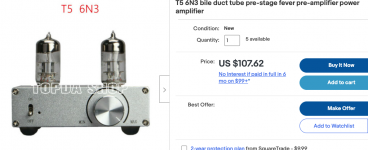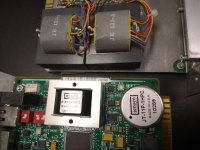I found a couple of things for sale that made me laugh pretty hard so I want to share this with the community. I hope you get a laugh too. Its holiday season here so let's go with this.
The first is the "Dual Vacuum Tube Bile Duct Earphone Amplifier".
Apparently it gets a one thumb up rating according to the picture.

The next is the "bile duct tube pre-stage fever pre-amplifier" on Ebay.
They have the pre-amp with the fever and it's still a bile duct amplifier.

The first is the "Dual Vacuum Tube Bile Duct Earphone Amplifier".
Apparently it gets a one thumb up rating according to the picture.

The next is the "bile duct tube pre-stage fever pre-amplifier" on Ebay.
They have the pre-amp with the fever and it's still a bile duct amplifier.

There was a pretty good explanation on this thread last year:
I'm a Chinese. I don't know what 'bile' refers to here but hope my answer helps you understand 'fever' better.
'Having a fever' in Chinese we say "发烧“(fa shao), and in China we call audiophiles as "发烧友"(fa shao you), ‘友you' means friend. The story behind this word is said that in the 1950s amplifiers are all velve which were hot and made sweat dripping from the forehead of the audiophiles in HongKong and their face were red in hot summer like getting a fever. So they jokingly called themselves as 'fashao'. But nowadays this word has extended its meaning to someone who has enthusiasm for sth like car, electronic devices,etc.
Then back to hardware descriptions, there is a popular phrase "发烧级”(fa shao ji) —’ji‘ means Grade—among ads of hardware products, trying to impress customers that it is with high quality, like faster in the context of GPU, and it is in Hifi Grade in audio products. Or sometimes they just use fashao as an adjective, like fashao DAC, fashao amp.
At the present time, fashao is the way to test and see if you have caught COVID-19. So one audiophile in my wechat groupchat did remind us days ago not to mention fashao or call yourself fashao these days because it is no good luck.
Hey kodabmx, I like those fever cows. They almost look like the real thing.
I've got loads of the real things pulled from radio broadcast consoles. What I'd like to see at aliexpress would be the Moooo-ving-coil step up Fever Cow.
Jensen has their transformers suspended in a potting compound inside the shield can and the can is then completely sealed off.
Jensen shield cans are made of Mu metal and the Fever Cow transformers?
Maybe Mooo metal?
Jensen has put a huge amount of work into R&D to get the highest quality and a look at the data sheets shows how excellent they are.
Jensen shield cans are made of Mu metal and the Fever Cow transformers?
Maybe Mooo metal?
Jensen has put a huge amount of work into R&D to get the highest quality and a look at the data sheets shows how excellent they are.
I didn't realize Jensen transformers was a different company
I assumed it was Jensen Electronics - Wikipedia and avoided it like the hot trash Jensen car audio is.
I assumed it was Jensen Electronics - Wikipedia and avoided it like the hot trash Jensen car audio is.
Jensen audio transformers are the industry standard. They're found in mixing boards and pro equipment.
Jensen JT-11P-1 Premium Line Input Transformer 1:1
Edit: This transformer has been around for decades, provides ground loop isolation, and can be used for single ended to balanced or vice-versa.
Here's a consumer product that uses them.
Jensen Iso-Max CI-2RR RCA Stereo Line Input Isolator Hum Eliminator
Jensen JT-11P-1 Premium Line Input Transformer 1:1
Edit: This transformer has been around for decades, provides ground loop isolation, and can be used for single ended to balanced or vice-versa.
Here's a consumer product that uses them.
Jensen Iso-Max CI-2RR RCA Stereo Line Input Isolator Hum Eliminator
Last edited:
Triad TY-250P
I looked at those a while back and they had zero in stock and long wait time.
It looks like they got the memo. People are using audio transformers in DACs. An audio transformer is an easy solution to break the ground loop associated with Bluetooth boards. Audio transformers were eschewed by the hi fi community for decades, and now they're back.
The Jensen transformers are a little smaller and potted. They're also 15 times the price. I'm going to order a couple Triad transformers and check them out.
Here are some interesting Jensen Transformers for display.
The old JE 123-A on the top are line output high signal level steel lamination core transformers. Loved by people in music production for their added colouration of the sound. Long out of production. The shiny laminate transformer below them is the modern JT-11-HFMPC. A line output transformer with 80% nickel alloy core laminations. The nickel cores are very linear at low signal levels and thought to be without it's own sound and noted for the detail that they convey.
So a big sonic contrast between these two transformers. The Modern Jensen output transformers are offered in either 50% or 80% nickel. But they will be happy to make one for you with steel laminations if you ask them.
Now think about the period of great old rock records that just sounded so sonicly involving. Like the old Stones records and Led Zeppelin. The many transformers in the signal path were part of that sound. You had a transformer in the microphone, one at the mic preamp input, one at the console channel strip output, one at the console buss output and one at the multitrack tape machine channel input. And that's just going to multitrack tape. When mixing it was multitrack tape channel output transformer to console line input transformer to channel strip output transformer to the mix bus output transformers to the two track tape input transformers.
Also all of the op amps were made with discrete transistors and that also was part of that great sound too. Everything mentioned was relatively expensive to make and when the monolithic op amps like the NE5532 came around the business of recording equipment became a cost contest. Cheap op amps and cheap electrolytic coupling capacitors became the modern way and that replaced the audio transformers. Loads of NE5532s in a signal path in series has its own sound signature and it is very different than what we hear with the great old gear.
The old JE 123-A on the top are line output high signal level steel lamination core transformers. Loved by people in music production for their added colouration of the sound. Long out of production. The shiny laminate transformer below them is the modern JT-11-HFMPC. A line output transformer with 80% nickel alloy core laminations. The nickel cores are very linear at low signal levels and thought to be without it's own sound and noted for the detail that they convey.
So a big sonic contrast between these two transformers. The Modern Jensen output transformers are offered in either 50% or 80% nickel. But they will be happy to make one for you with steel laminations if you ask them.
Now think about the period of great old rock records that just sounded so sonicly involving. Like the old Stones records and Led Zeppelin. The many transformers in the signal path were part of that sound. You had a transformer in the microphone, one at the mic preamp input, one at the console channel strip output, one at the console buss output and one at the multitrack tape machine channel input. And that's just going to multitrack tape. When mixing it was multitrack tape channel output transformer to console line input transformer to channel strip output transformer to the mix bus output transformers to the two track tape input transformers.
Also all of the op amps were made with discrete transistors and that also was part of that great sound too. Everything mentioned was relatively expensive to make and when the monolithic op amps like the NE5532 came around the business of recording equipment became a cost contest. Cheap op amps and cheap electrolytic coupling capacitors became the modern way and that replaced the audio transformers. Loads of NE5532s in a signal path in series has its own sound signature and it is very different than what we hear with the great old gear.
Attachments
There's also Hammond for us Canadians... http://www.hammondmfg.com/pdf/140TEX.pdf
The bandwidth on that 140TEX looks impressive.
I've used both Hammond high voltage power supply transformers and power supply chokes for several tube amplifiers that I have built and I'm happy with them. Their chassis as well. I've used the steel and aluminum chassis boxes with good results.
Hammond has a deep line of products.
I've used both Hammond high voltage power supply transformers and power supply chokes for several tube amplifiers that I have built and I'm happy with them. Their chassis as well. I've used the steel and aluminum chassis boxes with good results.
Hammond has a deep line of products.
There's also Hammond for us Canadians... http://www.hammondmfg.com/pdf/140TEX.pdf
Hammond transformers have always been popular here, especially among musicians. I've seen Hammond transformers specified for many projects.
I did not know they made a line level transformer that competed with the Jensen transformers. It looks nice.
- Home
- Member Areas
- The Lounge
- Bile Duct Amplifiers

